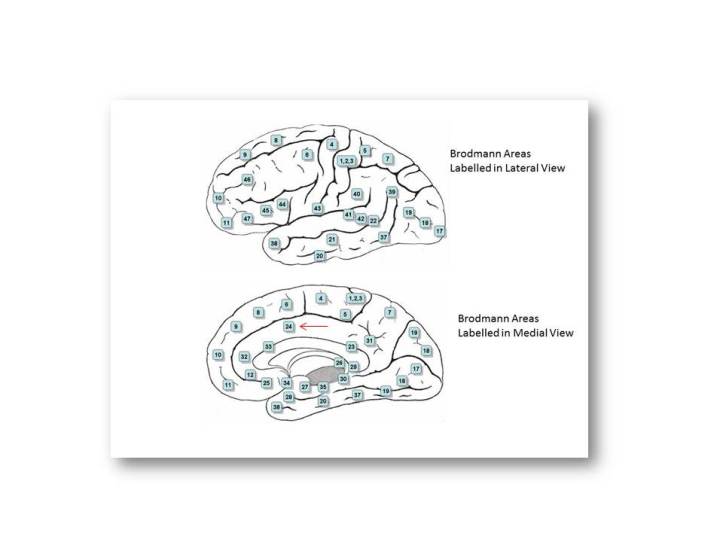 The Anterior Cingulate Cortex, Brodmann Area 24, Derived from Gray’s Anatomy 20th Edition 1918 Lithograph Reproduction, Public Domain
The Anterior Cingulate Cortex, Brodmann Area 24, Derived from Gray’s Anatomy 20th Edition 1918 Lithograph Reproduction, Public Domain
The brain is a complex structure and but can be organised according to several principles. One approach is to characterise the brain regions according to the microscopic properties of these regions. More specifically the neurons are organised differently between regions. Some regions may contain unique types of neurons. This approach to understanding the organisation of the brain was proposed by the German Neuropathologist Korbinian Brodmann and resulted in the eponymously named Brodmann Area. There are 52 areas in all and I have covered other Brodmann Areas elsewhere in this Blog. Brodmann Area 24 is also known as the Anterior Cingulate Cortex and is also referred to as the brain’s awareness centre. This is however a simplified way of viewing this part of the brain which has many other functions. Here are 5 studies which tell us more about this part of the brain.
#1 Gender differences have been revealed in the Anterior Cingulate Cortex. In this study, researchers looked at 70 adults consisting of age-matched men and women. The researchers found that women had larger grey matter volume in Area 24 compared to their age-matched male counterparts. Although interesting such conclusions need to be verified by large scale replications.
Hagmann et al, (2008), Extract from Figure 1 from Mapping the Structural Core of Human Cerebral Cortex, PLoS Biol 6(7): e159, Creative Commons 2.5 License
#2 Loss of awareness of cognitive deficits in Alzheimer’s Disease has been associated with decreased activity in the Anterior Cingulate Cortex. In one study, researchers looked at 29 people with Alzheimer’s Disease (paper freely available here). The researchers used functional Magnetic Resonance Imaging to indirectly examine brain activity during cognitive testing. The subjects were administered a neuropsychological battery. Compared to a control group there was evidence that for the people with Alzheimer’s Disease there was decreased activity in the right Anterior Cingulate Cortex. Functional Magnetic Resonance Imaging gives an indirect indication of brain activity by looking at changes in oxygenation of the blood. The researchers hypothesised that the Anterior Cingulate Cortex was part of a brain circuit that included the Frontal Cortex which was directly involved in maintaining awareness of cognition. The findings confirmed their hypothesis. Although this hypothesis offers clarity in the area of insight it will be interesting to see the results of larger replication studies
#3 There are neurotransmitter differences between the Anterior and Posterior Cingulate Cortex. Brodmann suggested that the Cingulate Cortex could be divided into two regions. However a contemporary neurobiological model posits a division into four distinct parts. The researchers in this autoradiography study (see here) examined neurotransmitter levels in the Cingulate Cortex and provided evidence to support the division into four rather than two parts. They found that compared to the Posterior Cingulate Cortex, the Anterior Cingulate Cortex manifested significantly higher levels of AMPA, Kainate and GABA(B) amongst other neurotransmitter receptors.
#4 The Anterior Cingulate Cortex contains the most well-connected neurons in the brain. The Von Economo neurons are widely connected to neurons in many other parts of the brain. The researchers in this study confirmed the presence of Von Economo neurons in the Anterior Cingulate Cortex as well as Brodmann Area 9.
#5 The Anterior Cingulate Cortex is one of several areas that is deactivated during spontaneous musical experiences. Single Positron Emission Computed Tomography was used to identify the neural correlates of spontaneous musical experiences in 150 Otolaryngologists and 100 musicians in this study. The researchers found deactivation of the Anterior Cingulate Cortex during these spontaneous experiences without external auditory stimuli.
An index of the site can be found here. The page contains links to all of the articles in the blog in chronological order. Twitter: You can follow ‘The Amazing World of Psychiatry’ Twitter by clicking on this link. Podcast: You can listen to this post on Odiogo by clicking on this link (there may be a small delay between publishing of the blog article and the availability of the podcast). It is available for a limited period. TAWOP Channel: You can follow the TAWOP Channel on YouTube by clicking on this link. Responses: If you have any comments, you can leave them below or alternatively e-mail justinmarley17@yahoo.co.uk. Disclaimer: The comments made here represent the opinions of the author and do not represent the profession or any body/organisation. The comments made here are not meant as a source of medical advice and those seeking medical advice are advised to consult with their own doctor. The author is not responsible for the contents of any external sites that are linked to in this blog.

[…] #5 Studies That Tell Us About the Brain’s Awareness Centre – The Anterior Cingulate Cort… […]
LikeLike
[…] #5 Research Papers That Tell Us About the Anterior Cingulate Cortex (AKA Brodmann Area 24) […]
LikeLike
[…] Research has shown the Anterior Cingulate Cortex is part of a brain circuit that includes the Frontal Cortex which is d…. Apparently, some areas of the Anterior Cingulate Cortex functionality can be deactivated by […]
LikeLike